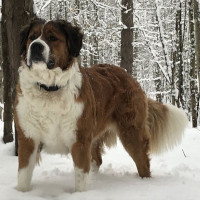Appearance of the Saint Bernese
|
| The Saint Bernese is a cross between a St. Bernard and a Bernese Mountain Dog, two large dogs. The result is a giant dog that can weigh up to 55 kilos. These gentle giants are adorable, sturdy dogs of great stature, with a dense, thick coat. Their bodies are well proportioned, being longer than they are tall. He has a deep chest and a solid, well-muscled body. His strong legs are well suited to his heavy body, and his paws are rounded and almost the size of a bear's paw. The drooping ears on either side of the head frame the face, and the pointed muzzle gives this dog an air of anticipation and alertness. The eyes are round, dark, expressive and large. The Saint Bernese drools a little and has hanging lips, but its cheerful face and adorable nature will make it a popular companion. Built like a workhorse with plenty of power and energy, this dog needs an active family to help him expend his energy. |
Temperament of the Saint Bernese
|
| These huge, lovable dogs have gentle personalities and are known for their calm, confidence and affection. Incredibly loyal, they make ideal companions and family dogs. He is patient and tolerant with young children, and loves to play with them or watch over them as he will be their protector. These gentle giants are intelligent dogs, but they can sometimes be a little stubborn. Keep training fun and sessions short so your dog doesn't get bored or lose concentration. Like most dogs, they respond well to praise and an occasional treat. However, don't be too generous with treats, as they can put on weight easily, which can lead to health problems. He's an ideal dog to accompany you on a walk, because even when you're cycling, he'll keep pace with you, even if he sometimes wants to stop and explore. Saint Bernese puppies are the cutest bundles of cuddles, but during their growth phase, take care not to exercise them too much until their bones are stronger. They take time to mature, so they seem to stay puppies longer than most dogs. But this only makes the Saint Bernese even more adorable to its owners. Treat stubbornness with patience and try to use positive reinforcement to overcome it. These dogs adapt to most climates, except extreme heat. Apartment living is not for them, as their size can be overwhelming in a small space, but they are at home in a house with a garden big enough for them to explore and play. The Saint Bernese is not an aggressive dog, although its size is enough to deter prowlers. Calm, thoughtful, but sometimes a little zany, these gentle dogs enjoy spending time with their families and will be loyal and devoted companions. |
Needs and activities of the Saint Bernese
|
| The Saint Bernese is an active dog that will enjoy a daily walk or trot alongside you when you run. They're not hyperactive, but they like to have a lot to do every day. These mild-mannered dogs also enjoy meeting their friends in the dog park, and it's a great way to socialize them to accept other people and other dogs. At home, they love to play and are good with children, although their size can sometimes knock little ones over unintentionally. These dogs are perfect for active families, and love to take part in hikes or explore the countryside. They respond well to training, but have a stubborn streak that must be taken into account. The Saint Bernese is not an apartment dog, taking up far too much space and needing plenty of room for exercise. He's best suited to a home with a large, fenced-in yard. The Saint Bernese is an intelligent dog who likes to please, so keep him busy, take him for a walk and he'll be delighted to snooze at your feet in the evening. |
Maintenance of the Saint Bernese
|
| The dense coat of the Saint Bernese requires a lot of brushing to keep it tidy and to remove loose hairs. These dogs shed a lot, so if you don't like cleaning the hair off your floor and furniture every day, the Saint Bernese may not be for you. A good daily brushing with hard bristles will remove most of the loose hair and prevent your dog's coat from matting. Bathing can be an effort, but fortunately these dogs don't need it very often. Don't forget to use a special shampoo for dogs, gentle and non-aggressive on their skin. Their eyes are prone to problems, so make sure they're not red or watery, and have them examined by your vet to clear them up. Ears should also be checked in case a build-up of dirt and wax causes inflammation. Toenails should be trimmed, especially if they make a clicking noise on the floor - a sure sign that they're too long. Simply trim them lightly, taking care not to cut into the nail bed, which could cause your dog pain. Finally, a good brushing of the teeth in and around this big dog's lips. Although it may take some time, prevention is always much easier than treating a problem. |









 English (United Kingdom)
English (United Kingdom)